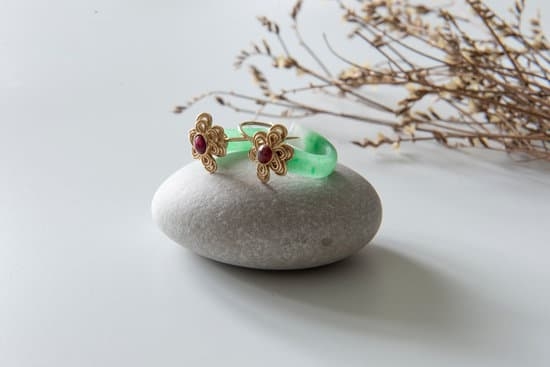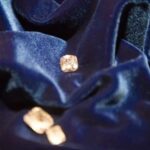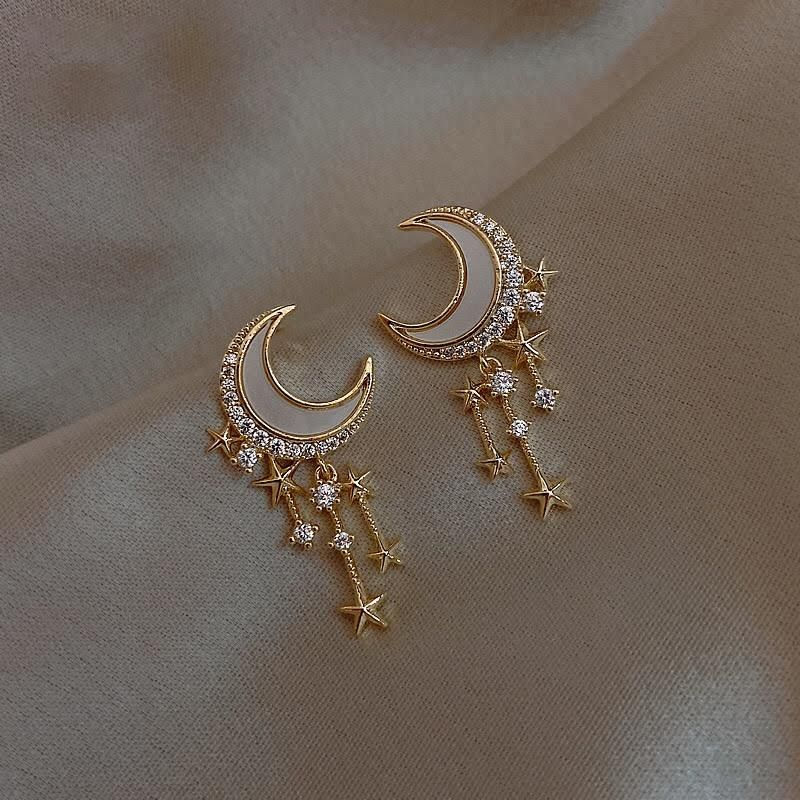In recent years, there has been a notable shift in the jewelry industry. More and more people are turning to moissanite as a diamond alternative. With its remarkable resemblance to diamonds and significantly lower price point, moissanite has quickly gained popularity among those seeking an affordable yet stunning option for their jewelry pieces.
Abby Sparks Jewelry, a renowned name in the industry, has been at the forefront of this trend, offering high-quality moissanite engagement rings and other exquisite pieces. But can moissanite truly pass for a diamond? In this article, we will delve into this question and explore the fascinating world of moissanite as a diamond alternative.
Before we uncover the answers, it is important to first understand what exactly moissanite is and how it is created. Often mistaken for diamonds due to their similar brilliance and fire, moissanites are actually naturally occurring gemstones that originate from meteorites.
However, today’s commercial production of moissanite involves creating these gemstones in laboratories through advanced technology that simulates the extreme conditions that occur during natural formation processes. Through this process, scientists have successfully recreated the unique chemical composition of moissanite, resulting in gems that closely mimic the visual characteristics of diamonds.
While diamonds have long been held in high regard for their exceptional beauty and durability, there are several reasons why some individuals are opting for moissanite instead. One major factor is their cost difference. Diamonds can come with exorbitant price tags due to factors such as rarity and market demand.
On the other hand, moissanites offer an attractive alternative at a fraction of the price without compromising on quality or aesthetics. This affordability has made them particularly popular among younger couples or those who value budget-conscious choices without sacrificing elegance and luxury.
As we embark on our exploration of moissanite’s potential to pass for a diamond, it is essential to recognize the contributions of Abby Sparks Jewelry in revolutionizing the moissanite experience. This renowned jewelry brand has recognized the demand for high-quality alternative gemstones, and their collection of moissanite pieces has become highly sought after.
With a commitment to craftsmanship and timeless designs, Abby Sparks Jewelry offers customers an opportunity to own breathtaking jewelry that rivals diamonds in both beauty and allure.
With an overview of the rising popularity of moissanite and its position as a diamond alternative, we can now delve into the specifics. In the following sections, we will demystify moissanite by exploring its creation process and comparing its characteristics against diamonds.
We will also hear from customers who have first-hand experiences with moissanite from Abby Sparks Jewelry and discover insider tips on how to differentiate between these two precious gems. By the end of this article, we aim to debunk any doubts surrounding moissanite’s ability to pass for a diamond and provide a comprehensive understanding of its unique appeal in today’s jewelry market.
Demystifying Moissanite
Moissanite is a naturally occurring mineral, consisting of silicon carbide, which was first discovered in 1893 by French scientist Henri Moissan. At the time, scientists believed that the mineral originated from space, as it was found in a meteor crater in Arizona. However, it was later discovered that moissanite can be created in a lab through a process called thermal growing.
Thermal growing involves simulating the conditions under which moissanite forms naturally. The process begins with small silicon carbide seeds, which are placed in a high-temperature furnace along with carbon-rich sources such as graphite or hydrocarbons. This mixture is then subjected to extremely high temperatures of over 2,000 degrees Celsius for several hours.
During this time, the silicon carbide vaporizes and then condenses on the seeds to form larger crystals. The resulting crystals are then cut into various shapes and sizes to be used as gemstones. The finished moissanite gemstones have similar physical properties to diamonds and are known for their brilliance and fire.
One of the advantages of creating moissanite in a lab is that it allows for greater control over the quality of the gemstone. Lab-created moissanite tends to have fewer impurities and flaws compared to naturally occurring moissanite. Additionally, by creating moissanite in a lab, its availability becomes more sustainable compared to mining diamonds from the earth.
A Closer Look at Diamonds
Diamonds are known for their unique and captivating characteristics that set them apart from other gemstones. It is important to understand these distinguishing features in order to properly compare diamonds with moissanite as a diamond alternative.
The 4Cs: Cut, Color, Clarity, and Carat Weight
One of the primary factors that contribute to a diamond’s beauty and value is its cut. The cut refers to how well a diamond has been shaped and faceted. The quality of the cut determines how effectively light is reflected and refracted within the diamond, resulting in its brilliance and sparkle.
Color is another important characteristic of a diamond. While diamonds can be found in various colors, those that are truly colorless or near-colorless are considered more valuable. Gemological Institute of America (GIA), the leading authority on gemstone grading, uses a scale ranging from D to Z to categorize a diamond’s color.
Clarity refers to the presence or absence of internal or external flaws, known as inclusions and blemishes respectively. Flawless diamonds which have no visible imperfections under 10x magnification are exceedingly rare and thus more valuable.
Carat weight is perhaps one of the most well-known characteristics when it comes to diamonds. It refers to the size or weight of the diamond, with one carat equaling 200 milligrams or 0.2 grams.
Diamond Certification
In order to ensure transparency and authenticity in the diamond industry, reputable jewelers often provide certification from independent gemological laboratories such as GIA or American Gem Society (AGS). These certifications outline important details about the diamond’s characteristics such as its cut grade, color grade, clarity grade, carat weight, and any potential treatments it may have undergone.
By understanding these fundamental characteristics of diamonds, consumers can make more informed decisions when comparing them with moissanite as a diamond alternative. While moissanite shares some similarities with diamonds, it is important to note that there are distinct differences in their appearances, properties, and values.
Challenging the Norm
Moissanite has been gaining popularity as a diamond alternative in recent years. With its unique properties and resemblance to diamonds, many are questioning whether moissanite can truly compete with the real thing.
While diamonds have long been regarded as the pinnacle of luxury and status, moissanite offers a compelling alternative for those who want the brilliance and sparkle of a diamond without the hefty price tag. Moissanite is a lab-created gemstone that was discovered over a century ago by French chemist Henri Moissan. It is composed of silicon carbide and has similar optical properties to diamonds, such as high refractive index and impressive fire.
One of the main advantages of moissanite over diamonds is its affordability. On average, moissanite is about one-tenth the cost of a comparable diamond with the same carat weight. This significant price difference allows individuals to invest in larger and more extravagant pieces without breaking the bank.
Additionally, moissanite is known for its incredible durability, scoring 9.25 on the Mohs scale compared to diamonds’ perfect score of 10. This makes it an excellent choice for everyday wear, knowing that it can withstand the test of time.
To better understand how moissanite stacks up against diamonds in terms of appearance, let’s consider three key factors: brilliance, fire, and sparkle. Brilliance refers to the white light reflecting back from a gemstone when exposed to light. Moissanite exhibits even greater brilliance than diamonds due to its higher refractive index. Fire refers to the dispersion of light into spectral colors, creating vibrant flashes or “fire.”
Again, moissanite outshines diamonds in this aspect with its exceptional ability to disperse light into colorful flashes. Lastly, sparkle refers to the combination of brilliance and fire that creates an overall dazzling effect on a gemstone. While both moissanite and diamonds offer sparkling displays, some argue that moissanite actually provides a more noticeable sparkle due to its increased brilliance and fire.
Comparing the Appearance
When it comes to choosing between moissanite and diamonds, one of the major factors that sets them apart is their appearance. Both gemstones are known for their brilliance, fire, and sparkle, but there are distinct differences in how they reflect light.
Moissanite, also known as silicon carbide, is a stunning gemstone that rivals diamonds in terms of brilliance. Its refractive index is higher than that of diamonds, meaning that it reflects more light and gives off a greater amount of sparkle. In fact, moissanite often exhibits a unique rainbow-like effect called “dispersion,” which showcases its exceptional fire. This means that even in low-light conditions or under candlelight, moissanite still offers an impressive display of light reflection.
On the other hand, diamonds have long been revered for their unmatched clarity and brilliance. With their superior hardness and ability to reflect light in all directions with unmatched scintillation and sparkle, diamonds have become the standard by which all other gemstones are measured. The natural properties of diamonds allow them to disperse light more efficiently than any other gemstone, resulting in a dazzling play of colors.
It is important to note that while moissanite may appear similar to diamonds at first glance, with its brilliance and sparkle being virtually indistinguishable to the untrained eye, there are subtle differences upon closer inspection. Moissanite often shows more color flashes compared to diamonds due to its higher refractive index and dispersion. Additionally, some individuals may prefer the unique rainbow-like effect displayed by moissanite over the traditional white sparkle of diamonds.
Ultimately, the choice between moissanite and diamond will depend on personal preference regarding appearance. Those who value maximum brilliance and dispersion might opt for moissanite’s rainbow-like effect while others might prefer the timeless beauty of a traditional diamond. Regardless of choice, both gemstones offer stunning beauty that can adorn jewelry pieces with elegance and style.
Price Points
As consumers, one of the key factors that often influences our purchasing decisions is the price. When it comes to making a choice between moissanite and diamonds, the significant cost difference between the two can play a major role. In this section, we will explore and compare the price points of moissanite and diamonds to help you make an informed decision.
Moissanite: A Cost-Effective Alternative
One of the main reasons why moissanite has gained popularity as a diamond alternative is its affordability. Compared to diamonds, moissanite offers a similar level of beauty and brilliance at a fraction of the cost. On average, moissanite costs about 90% less than diamonds with comparable carat weights. This makes it an attractive option for budget-conscious individuals who still want a stunning piece of jewelry.
The price of moissanite is influenced by various factors such as size, cut, color, and clarity. However, even with high-quality grades in these categories, moissanite remains significantly more affordable than diamonds. This affordability allows customers to purchase larger stones or opt for custom designs without breaking the bank.
Diamonds: A Symbol of Luxury at Higher Price Points
Diamonds have long been associated with luxury and prestige due to their scarcity and higher price points compared to other gemstones. The value of diamonds is determined by their 4Cs: carat weight, cut, color, and clarity. Natural diamonds that score high in all these categories are rare and therefore come at a premium price.
The cost of diamonds can vary greatly depending on these factors as well as market demand and trends. Additionally, natural diamonds are often more expensive due to sourcing concerns such as ethical considerations or mined from conflict zones.
In recent years, lab-grown diamonds have emerged as a more affordable alternative within the diamond industry. These diamonds have identical characteristics to natural ones but are created in a laboratory setting. Lab-grown diamonds offer a cost-effective option for those who desire the look and feel of diamonds without the high price tag associated with natural stones.
Making an Informed Decision
Ultimately, the decision between moissanite and diamonds comes down to personal preferences, budget, and value. If financial considerations are more important to you than owning a natural diamond, moissanite offers an excellent alternative that provides exceptional beauty and quality at a lower price point. On the other hand, if owning a natural gemstone is of utmost importance or if you are drawn to the prestige associated with diamonds, then investing in a diamond might be the right choice for you.
By understanding the significant cost difference between moissanite and diamonds, you can make an informed decision based on what matters most to you. Whether it’s finding an affordable option without compromising on elegance or indulging in luxury with a diamond investment, there is a choice for every jewelry lover.
Abby Sparks Jewelry
Abby Sparks Jewelry, a leading name in the jewelry industry, has been revolutionizing the moissanite experience for its customers. With their expertise and creativity, they have been able to showcase the beauty and elegance of moissanite in ways that were previously unseen. Through their unique designs and exceptional craftsmanship, they have made a mark in the market by offering stunning alternatives to diamond jewelry.
At Abby Sparks Jewelry, every piece is handcrafted with precision and attention to detail. Their designers work closely with their clients to understand their preferences and create customized pieces that truly reflect their personality. Their use of moissanite as the center stone in many of their designs has gained significant popularity due to its brilliance, fire, and sparkle.
One of the notable features of Abby Sparks Jewelry is their commitment to sustainability. Moissanite is an eco-friendly gemstone that is created in a laboratory setting rather than being mined from the earth. This makes it a more sustainable option compared to diamonds, which require extensive mining processes. By showcasing moissanite as an alternative to traditional diamond jewelry, Abby Sparks Jewelry promotes ethical practices without compromising on style or quality.
Why Choose Abby Sparks Jewelry?
- Customization: Abby Sparks Jewelry offers personalized designs that cater to individual preferences. Whether it’s an engagement ring or a special occasion piece, you can work with their expert designers to bring your vision to life.
- Quality Craftsmanship: Each piece created at Abby Sparks Jewelry is meticulously crafted using only the finest materials and techniques. Their attention to detail ensures that every item is of exceptional quality.
- Affordable Luxury: By choosing moissanite instead of diamonds, Abby Sparks Jewelry offers luxury jewelry at more affordable price points. This allows customers to access high-quality pieces without breaking the bank.
Abby Sparks Jewelry has redefined the perception of moissanite by showcasing its unique characteristics and beauty through their stunning creations. With their innovative designs, commitment to sustainability, and personalized approach, they have truly revolutionized the moissanite experience for jewelry enthusiasts.
Customer Testimonials
At Abby Sparks Jewelry, we pride ourselves on providing our customers with exquisite moissanite jewelry that rivals the beauty and quality of diamonds. But don’t just take our word for it – hear what our satisfied customers have to say about their real-world experiences with moissanite.
- Unmatched Beauty and Brilliance: One of the most common praises we receive from our customers is how stunning and sparkly their moissanite jewelry looks. Many have mentioned that even in direct sunlight, their moissanite engagement rings and earrings shine brighter than any diamond they’ve seen. The brilliance, fire, and sparkle of moissanite truly leave a lasting impression.
- Affordability Without Compromise: Another aspect that stands out to our customers is the significant cost difference between moissanite and diamonds. Many have expressed their appreciation for being able to afford larger carat sizes or more intricate designs without breaking the bank. They are thrilled to own a beautiful piece of jewelry that looks just as luxurious as if it were set with diamonds.
- Durability and Longevity: Our customers often mention how well their moissanite jewelry has held up over time. Moissanite is known for its hardness and resistance to scratches, making it an excellent choice for everyday wear. Several testimonials highlight how their moissanite rings still look brand new after years of use, which further solidifies the durability of this alternative gemstone.
- Ethical and Sustainable Choice: Many individuals also appreciate the ethical considerations associated with choosing moissanite over traditional diamonds. As a lab-created gemstone, moissanite eliminates concerns related to conflict diamonds or unsustainable mining practices. Our customers value knowing that they can wear their beautiful jewelry without contributing to any harm or exploitation.
Insider Tips
While moissanite has gained popularity as a diamond alternative, it is essential to know how to differentiate between the two. Understanding the characteristics of both gemstones will help you make an informed decision when purchasing jewelry. Here are some insider tips on how to distinguish moissanite from diamonds.
One of the easiest ways to tell moissanite apart from diamonds is by looking at their color. Diamonds typically have a white or colorless appearance, whereas moissanite can exhibit a slight yellow or greenish tint that becomes more visible in certain lighting conditions. However, it is important to note that some lower-quality diamonds may also possess a noticeable color, so this factor alone may not be definitive.
Another characteristic to consider is clarity. Diamonds are known for their incredible clarity, with most having very few internal flaws or inclusions. On the other hand, moissanite often includes small imperfections called needles due to its natural growth process. These needles can be seen under magnification and can help differentiate between the two gemstones.
Next, examine the brilliance and sparkle of the stone. While diamonds are renowned for their ability to reflect light, moissanite exhibits even greater fire and brilliance thanks to its unique faceting pattern. The sparkle of moissanite tends to be more colorful and intense compared to diamonds. Observing these differences side by side can enable you to identify which gemstone is which.
Lastly, consider the weight or specific gravity of the stones. Moissanite has a higher density than diamonds, making it slightly heavier when compared in equal sizes. By using a scale specifically designed for this purpose or seeking professional assistance at a reputable jeweler’s shop, you can determine which stone weighs more and thereby differentiate between them accurately.
By understanding these insider tips on differentiating between moissanite and diamonds, you will gain confidence in distinguishing one from another during your next jewelry shopping adventure. Knowing the characteristics of each gemstone will help you choose the option that best suits your desires and budget while still getting the stunning sparkler you crave.
Conclusion
In conclusion, the rising popularity of moissanite as a diamond alternative is not without merit. Through this article, we have gained an understanding of what moissanite is and how it is created, as well as explored the characteristics that set diamonds apart. We have also delved into the debate of whether moissanite can truly compete with diamonds.
When comparing their appearance, moissanite undeniably exhibits brilliance, fire, and sparkle that rival those of diamonds. The significant cost difference between moissanite and diamonds makes the former an attractive option for budget-conscious consumers.
Abby Sparks Jewelry has played a pivotal role in revolutionizing the moissanite experience by offering beautifully crafted jewelry pieces that showcase the true beauty of this gemstone. Through customer testimonials, we have heard real-world experiences that validate the ability of moissanite to pass for a diamond.
While there are insider tips that can help differentiate between moissanite and diamonds upon close inspection, it is clear that moissanite has come a long way in debunking the myth surrounding its ability to pass for a diamond. With its stunning appearance and more affordable price point, it is no surprise that more and more individuals are choosing moissanite as their preferred choice for fine jewelry.
Frequently Asked Questions
Can moissanite diamond pass a diamond tester test?
Moissanite diamond, also known as synthetic moissanite, is a lab-created gemstone that shares some physical characteristics with natural diamonds. While a moissanite may closely resemble a diamond in terms of appearance and sparkle, it does not consist of the same chemical composition as a genuine diamond. In general, most diamond testers rely on thermal conductivity to differentiate between diamonds and other gemstones.
Since moissanite has significantly higher thermal conductivity than diamonds, it typically registers as “diamond” when tested by these devices. However, it’s important to note that there are certain advanced diamond testers available that can accurately identify moissanite as a separate stone. Therefore, while moissanite may initially pass a basic diamond tester test due to its thermal properties, further examination with specialized equipment can reveal its true identity.
Can a jeweler tell between moissanite and diamond?
Experienced and knowledgeable jewelers have the ability to distinguish between moissanite and diamond based on their expertise and careful observation. Although moissanites share many similarities with diamonds in terms of sparkle and clarity, subtle differences are present under close inspection. For instance, the brilliance pattern of moissanites tends to differ due to their double refraction property compared to the single refraction found in diamonds.
Additionally, when examined under certain lighting conditions or through magnification tools like microscopes or loupes, jewelers may notice differences in color dispersion or facet patterns between moissanites and diamonds. Training and experience play crucial roles in enabling jewelers to determine whether a gemstone is a genuine diamond or an alternative such as moissanite.
Which sparkles more moissanite or diamond?
The level of sparkle exhibited by both moissanite and diamonds can vary depending on various factors such as cut quality, size, shape, and lighting conditions. Moissanites are known for their exceptional fire or the ability to disperse light into spectral colors brilliantly. Due to this high refractive index (2.65-2.69), they often display more colorful flashes of light compared to diamonds.
However, diamonds possess a unique sparkle characterized by their high brilliance and scintillation. The superior refractive index of diamonds (2.42) contributes to their ability to reflect greater amounts of white light, leading to a stunning display of brightness and dispersion. Ultimately, the preference for either moissanite or diamond sparkle is subjective and depends on individual taste.

Welcome to my jewelry blog! My name is Sarah and I am the owner of this blog.
I love making jewelry and sharing my creations with others.
So whether you’re someone who loves wearing jewelry yourself or simply enjoys learning about it, be sure to check out my blog for insightful posts on everything related to this exciting topic!





